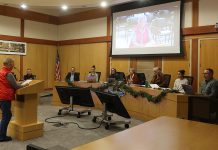County Planning Commissioners have approved a Syar gravel
company plan that would allow Syar to mine millions of tons of
gravel from Russian River sandbars in the Alexander Valley.
The in-stream mining project drew heartfelt support from
longtime Alexander Valley property owners who say unmanaged sandbar
build-up is causing bank erosion, worsening flood damage and
blocking seasonal fish passage to some tributary creeks.
“The River is full of brush and gravel,” said Geyserville
rancher Ray Pigoni at last week’s public hearing. “It needs to be
taken out.”
Culminating more than four years of review, Planning
Commissioners last week recommended approval of a use permit for
the instream mining and an amendment to the county’s Aggregate
Resource Management (ARM) plan that will allow Syar to haul up to
350,000 tons of gravel out of the River annually for the next 15
years. The deal could garner more than $6 million annually for Syar
under current market conditions, with the price of Russian River
aggregate at nearly $30 a cubic yard.
Syar, as a condition of approval, will undertake River riparian
enhancement projects intended to improve fish and wildlife
habitat.
Approximately 110 acres of sandbars will be mined on property
that Syar either owns or leases from property owners above
Healdsburg in a 6.5 mile stretch of River between Gill Creek and
the Jimtown Bridge.
Planners and property owners last week said Syar’s River
enhancement proposal is an unprecedented and welcome effort to
improve fish habitat and other River environmental conditions as a
condition of instream mining.
“This is the first time any gravel mining permit has taken into
consideration the fish and the environment,” said Healdsburg
resident Al Cadd, president of the Russian River Property Owners
Association whose 120 members support the plan.
Syar will pay for restoration of 26 acres of riparian habitat
and create a half-dozen River oxbows and alcoves to improve River
habitat including fish access to tributaries.
David Fanucchi, a third-generation Alexander Valley grape
grower, said he’s seen a lot of instream Russian River mining over
the years but “This is the first time I ever saw anybody willing to
plant willows as part of their mining operation.”
The enhancement work will be paid for with a 30-cent-per-ton fee
Syar will pay into a Russian River Gravel Mitigation Fund. The fees
are projected to generate more than $1.5 million over the life of
the mining activity based on a total of more than five million tons
of sand and gravel removed from the bars.
The project includes an “adaptive management strategy” meaning
Syar will submit a mining plan each year for review by
environmental resource agencies including the County Permit and
Resource Management Department (PRMD), the U.S. Army Corps of
Engineers, the state Department of Fish and Game and the National
Marine Fisheries Service.
Even critics of the project concede that Alexander Valley gravel
bar buildup is overdue for removal.
No mining has occurred in the lower Alexander Valley since 2001
and several floods have resulted in a “net sediment gain” of more
than one million cubic yards, with bar elevation increases up to
20-plus feet in some cases, said county planner Melinda Grosch in
her response to comments on the EIR.
“There has been a large aggradation in this particular reach,”
said Grosch.
The project would use improved mining methods to remove smaller
amounts of aggregate compared with unregulated mining in the early
1900s, 1940s and 1980s, when sometimes nearly a million tons a year
were mined instream, said Grosch.
Unregulated instream mining has been cited as one factor in the
decimation of the River’s native salmon and steelhead trout, now
listed as species threatened or endangered with extinction.
Among supporters at last week’s public hearing were
representatives of the local operating engineers union who said the
project will employ workers hit hard by the recession.
“This economy has completely devastated the construction
industry,” said union spokesman Chris Snyder speaking in support of
Syar.
But critics of the project questioned whether there’s sufficient
local market demand to justify taking 350,000 tons of gravel per
year out of the Russian River.
In the current down economy “No amount of aggregate mining is
going to spur construction,” said Healdsburg resident Don McEnhill
of the Russian Riverkeeper environmental watchdog project.
The local construction malaise means Syar has an incentive to
truck River gravel, a high-quality product used in Portland Cement
Concrete, to markets all over Northern California, said
McEnhill.
Riverkeeper had supported mining with environmental restoration
but wanted a lower annual maximum limit of 132,000 tons.
“Quite frankly we were shocked when the lower volume was tossed
out,” said McEnhill, who said the proposed volume of operations
could have big-rig gravel trucks rolling in and out of instream
mining sites at the rate of one truck every 90 seconds.
The proposed upper limit of 350,000 tons a year will create “an
industrial mining zone in the Alexander Valley,” said McEnhill.
Opponents also worried the adaptive management strategy means
Syar can change its plans every year without public input. County
planners said the annual review by environmental resource agencies
will provide adequate monitoring, and that watchdog groups such as
Riverkeeper can be part of the process.
“We would invite them to participate,” said PRMD Deputy Director
Jennifer Barrett. “Mining plans are public documents.”
The adaptive management strategy means Syar may not even work
some years, depending on how the River landscape changes and how
much gravel builds up or washes downstream.
With an adaptive management strategy, “They may not be able to
mine every year,” said Barrett.
Depending on River conditions, “We have the authority to stop
mining if there’s anything wrong,” said Barrett. “We do have the
authority to reduce mining. We feel we have adequate monitoring
controls.”
The standing-room-only hearing included dozens of mining
supporters wearing blue tags that said “Fans of the Russian
River.”
The commission voted 4-1 to approve the project. The lone
dissenting vote came from 5th District Planning Commissioner Pam
Davis who questioned the need for the amount of gravel being mined
and whether there were adequate opportunities for public
participation in the adaptive management strategy.
Other commissioners said they were convinced the mining and
restoration work will be an overall plus for the River.
“These are people that really love the River, said 4th District
Planning Commissioner Lisa Schaffner regarding Alexander Valley
property owners’ support.
With the environmental enhancement plans included in the
project, “This is offering something to the River that I don’t
think government could do right now,” said Schaffner.
The project still needs approval from the Sonoma County Board of
Supervisors who will consider it at an Oct. 26 public hearing.








